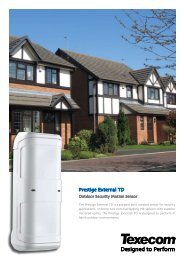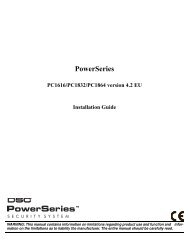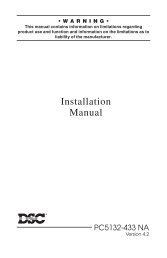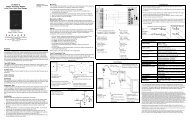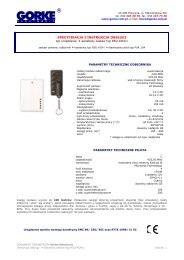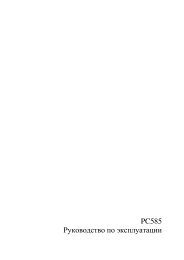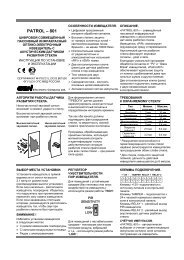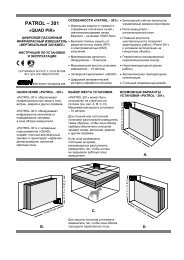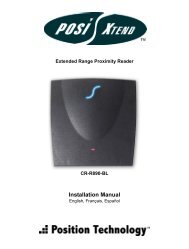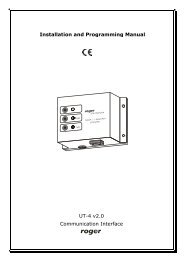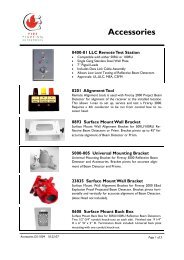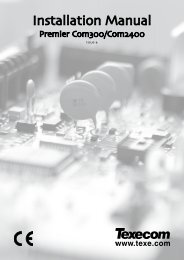RTS 100 (E).pdf - Gorke Electronic
RTS 100 (E).pdf - Gorke Electronic
RTS 100 (E).pdf - Gorke Electronic
You also want an ePaper? Increase the reach of your titles
YUMPU automatically turns print PDFs into web optimized ePapers that Google loves.
43-200 Pszczyna, ul. Staromiejska 31b<br />
tel. 032 326 30 70, fax 032 447 73 30<br />
www.gorke.com.pl, e-mail: biuro@gorke.com.pl<br />
SPECIFICATION AND USER’s MANUAL<br />
type of the device: <strong>RTS</strong>-<strong>100</strong> repeater<br />
TECHNICAL PARAMETERS<br />
• class: C<br />
• frequency: 433,92 MHz<br />
• radio transmission: Keeloq hopping code by Microchip<br />
Technology<br />
• type of receiving module: superreaction<br />
• sensitivity: -<strong>100</strong> dBm<br />
• sending power:
USER'S MANUAL<br />
The purpose of the elements:<br />
• BNC antenna socket – is used to connect 434 MHz/50 Ohm antennas<br />
• OPERATING MODE switch – defines the operating mode (with or without delay)<br />
• OPERATING STATE – signal the operating state of the device: CORRECT CODE, LEARNING,<br />
EMISSION, RECEPTION<br />
• LEARNING button – launches the learning procedures<br />
• SABOTAGE button – allows for connecting the device to an anti-sabotage line<br />
The receiver installation conditions - good. Firstly, the hermetic case allows for installing the receiver<br />
in difficult conditions such as humidity or low temperatures. It can work outside. Secondly, the<br />
superheterodyne receiving module is characterized by high resistance to electromagnetic interferences. In<br />
practice it means that the operating range is extended and the influence of interferences on the receiver’s<br />
work is minimized.<br />
The transmission code - the radio transmission, based on the hopping code (KeeLoq by Microchip<br />
Technology Inc. USA) ensures the high safety of using. Each transmission is different from the previous<br />
one. To make the receiver work, you must enter a remote control into its memory – it is the basic<br />
condition. The control can be programmed to unlimited number of receivers. „Loosing” 15 successive<br />
transmissions (using the remote control beyond the receiver's range) requires sending the signal twice<br />
(press the remote control button twice).<br />
Use:<br />
- extending the operating range of radio devices<br />
- reducing the costs in installations for many users with necessity of sending signal in a significant<br />
distance (several hundred metres). Here, instead of using remote controls of long range, you can<br />
use cheaper control, for example the PUK type<br />
- as a radio link relay station – sending information from a distant object to several receivers<br />
Frequency - the device works on the frequency 433,92 MHz. In majority of the European Union countries<br />
(including Poland) this bandwidth does not require any special permissions and concessions for using it.<br />
<strong>Gorke</strong> <strong>Electronic</strong><br />
SPECIFICATION AND USER’s MANUAL: repeater <strong>RTS</strong> <strong>100</strong> page: 2
1. FUNCTIONING DESCRIPTION<br />
After connecting the supply, the diode RECEPTION lights. It indicates that the receiver is ready to operate.<br />
With each correctly received transmission the diode fades for a moment. When it pulses, it indicates the<br />
incoming transmissions. If you want the retransmitter to send the received signals, you need to program<br />
it – to enter to its memory the codes of these senders which are supposed to be retransmitted. When<br />
using multi-button remote controls, you need to program each button separately. We applied such<br />
solution because in some uses it is not advisable to send signals from all the control's buttons. Each<br />
remote control button which is entered in the retransmitter is treated as a separate sender and occupies<br />
one slot in the memory. The memory capacity is 500 codes.<br />
Only those signals are retransmitted which come from a sender entered to <strong>RTS</strong> <strong>100</strong> memory. It<br />
cooperates with all types of senders by GE and some of the senders by other producers.<br />
2. PROGRAMMING A NEW SENDER TO THE RETRANSMITTER'S MEMORY<br />
To program a given sender or remote control to the retransmitter's memory:<br />
1. press the LEARNING button shortly – the LEARNING and RECEPTION diodes will light. The<br />
retransmitter is waiting to get the signal from the remote control<br />
2. press the remote control button which is supposed to be entered into the retransmitter's memory.<br />
After sending one signal from the control, the diode CORRECT CODE will light and the LEARNING diode<br />
will start to pulse. Press the control button once more. If the transmission is correctly received, all the<br />
diodes will light which confirms programming of the remote control.<br />
Repeat the programming for all the buttons in the remote control and next remote controls. Programming<br />
stationary senders is the same as the description in the manual; the only difference is that instead of<br />
pressing the control button, activate the sender to a short emission. The applied solution of individual<br />
programming buttons of a multi-button control allows for deciding which signals are supposed to be<br />
amplified.<br />
3. DELETING SENDERS FROM THE MEMORY<br />
To delete the remote controls' codes from the retransmitter's memory, press the LEARNING button and<br />
keep it pressed until all diodes light – then, release the LEARNING button. The diodes will light for about<br />
3s and then will fade which confirms the deletion. IMPORTANT! Remember that the deletion concerns the<br />
whole content of memory. If you want to delete only one or several remote controls, after the deletion<br />
process you must re-enter to the memory those controls which are supposed to be saved. Deleting the<br />
senders does not change the operating mode. Disconnecting the supply does not cause losing information<br />
about the entered remote controls and the operating mode of the retransmitter.<br />
If the retransmitter is in the the reception mode, then after receiving a correct transmission from a<br />
programmed remote control it will react by lighting the CORRECT CODE diode and then the EMISSION<br />
diode which confirms the receiver's work. After sending the received information, <strong>RTS</strong> moves to the<br />
reception mode.<br />
4. THE OPERATING MODES<br />
You can choose the <strong>RTS</strong> <strong>100</strong> retransmitter's operating mode:<br />
1. the immediate mode – after receiving a signal <strong>RTS</strong> <strong>100</strong> sends the received information<br />
2. the delay mode – the transmitter starts sending with a random delay from the scope 0,2-2 s. This<br />
mode is used in order to avoid collisions of operations of several retransmitters in the same area. <strong>RTS</strong><br />
<strong>100</strong> compares every received transmission with the 3 last transmitted ones and does not allow for<br />
repetitions and creation of a radio loop.<br />
DELAY switch allows you to choose the sender's operating mode:<br />
– without switch – after receiving a signal from the remote control the retransmitter starts sending<br />
immediately<br />
– with switch – after receiving a signal from the remote control, the retransmitter waits for 0,2-2s and<br />
starts sending<br />
– the delay is set randomly for each transmission<br />
– the delay operating mode is useful when there are several retransmitters operating on the same area<br />
<strong>Gorke</strong> <strong>Electronic</strong><br />
SPECIFICATION AND USER’s MANUAL: repeater <strong>RTS</strong> <strong>100</strong> page: 3



